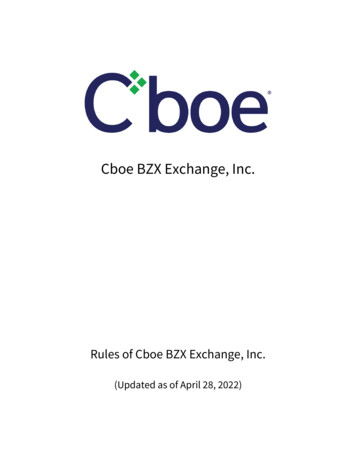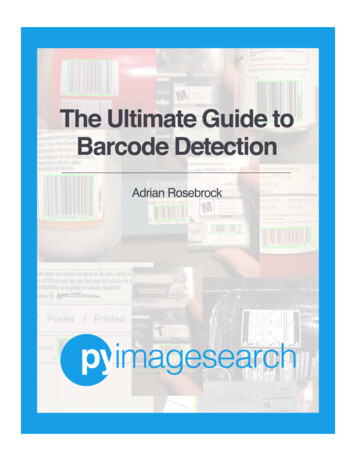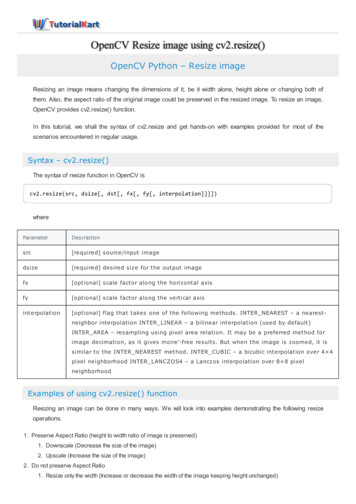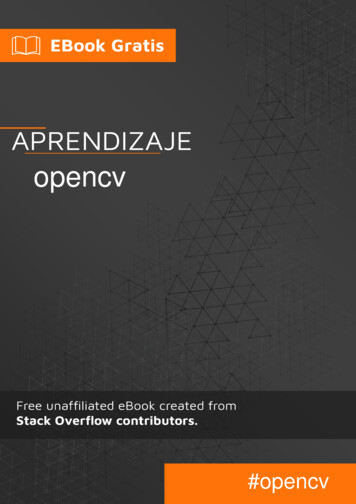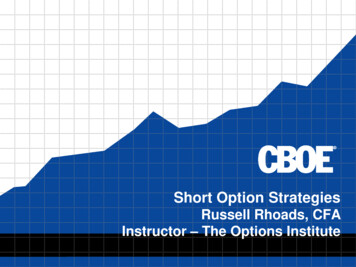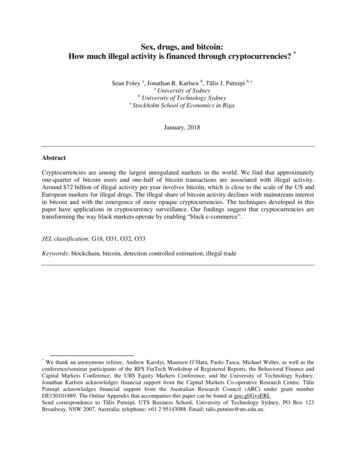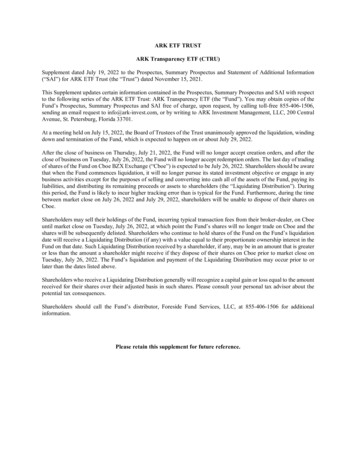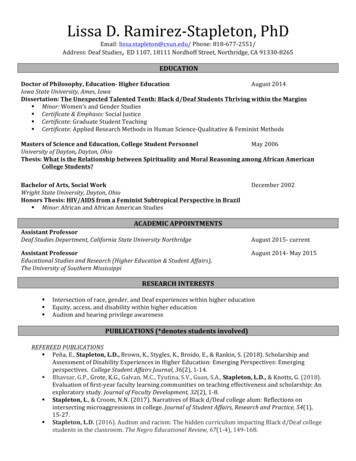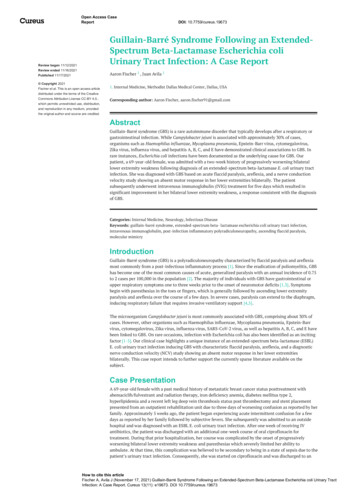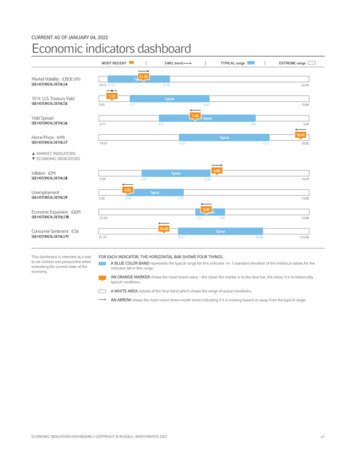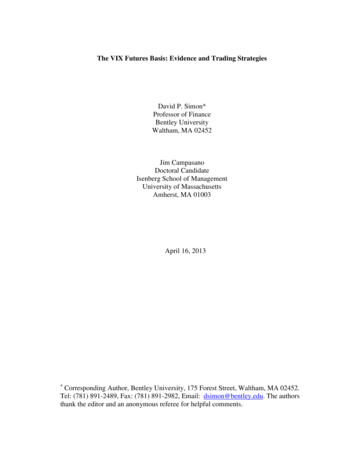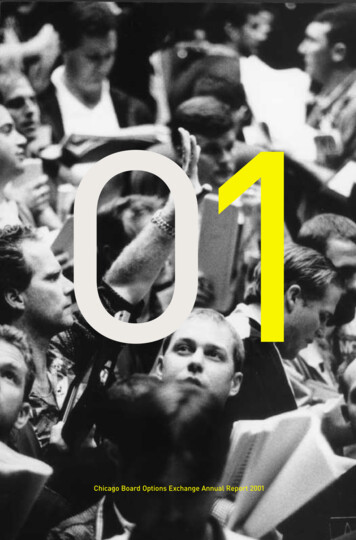
Transcription
01Chicago Board Options Exchange Annual Report 2001cv2 CBOE ‘01
101001010101010101010CBOE is the largest andmost successful optionsmarketplace in the world.ifc1 CBOE ‘01
ONE HAS OPPORTUNITIESThe NUMBER ONE Options Exchange provides customers with a wide selection of productsto achieve their unique investment goals.ONE HAS RESPONSIBILITIESThe NUMBER ONE Options Exchange is responsible for representing the interests of itsmembers and customers. Whether testifying before Congress, commenting on proposedlegislation or working with the Securities and Exchange Commission on finalizing regulations,the CBOE weighs in on behalf of options users everywhere. As an advocate for informedinvesting, CBOE offers a wide array of educational vehicles, all targeted at educating investorsabout the use of options as an effective risk management tool.ONE HAS RESOURCESThe NUMBER ONE Options Exchange offers a wide variety of resources beginning with alarge community of traders who are the most experienced, highly-skilled, well-capitalizedliquidity providers in the options arena. In addition, CBOE has a unique, sophisticated hybridtrading floor that facilitates efficient trading.01 CBOE ‘01
2 CBOE ‘01
“ TO BE THE LEADING MARKETPLACE FOR FINANCIAL DERIVATIVE PRODUCTS , WITH FAIR AND EFFICIENTMARKETS CHARACTERIZED BY DEPTH , LIQUIDITY AND BEST EXECUTION OF PARTICIPANT ORDERS . ”CBOE MISSIONLETTER FROM THE OFFICE OF THE CHAIRMANSINGLE - DAY RECORDVOLUME : 2,726,267CBOE HAS 40.5%OF TOTAL OPTIONSMARKET SHARECONSOLIDATIONUnprecedented challenges and a need for strategic agilitycharacterized a positive but demanding year in the overall optionsmarketplace. The Chicago Board Options Exchange (CBOE )enjoyed a record-breaking fiscal year, with a 2.2% growth in contractstraded when compared to Fiscal Year 2000, also a record-breaker.In addition, a record for fiscal year average daily volume was set in2001 with an average of 1,271,240 contracts traded daily, an increaseof 3.4% over FY 2000. During the week of April 16, 2001, CBOEexperienced three of the four busiest trading days in our history.The single-day record for trading volume was set on Wednesday,April 18, 2001 when 2,726,267 contracts traded. April 18 marked onlythe second time in the history of the Exchange that total volumesurpassed two and one-half million contracts.Due to the commitment of CBOE’s membership, the listing of newand attractive products, and exemplary customer service, CBOEretained its leadership position within the options industry in FiscalYear 2001, capturing a healthy 40.5% of total options market share,38.5% of equity options market share and 53.7% of index optionsmarket share. It is a market position that founders of many otherindustries would be thrilled to occupy 28 years after their first daysin business, but it is not an acceptable position to us. Despite volumegains, unrelenting competitive forces eroded overall market share inFY 2001—a situation that CBOE is taking aggressive steps to remedy.As the number one options exchange in the world for almost threedecades, CBOE is positioned as both the emulated leader and theprimary target for all competitors.As competitive pressures mounted, market makers and memberfirms devised strategies to combat them. Many of CBOE’s smaller,independent market-making firms were either acquired or becameaffiliated with larger firms in order to best service customers asconsolidation swept the options industry. Consolidation allowedfor the economies of scale so essential to success in today’sglobal economy.03 CBOE ‘01
EFFORTS TO ATTRACTCUSTOMERSIn support, CBOE redoubled its efforts to attract customers andprovide members with additional tools to service customer needs.Significant, attractive products were listed, a milestone joint venturewas created and sophisticated technological advancements wereintroduced to facilitate trading. Marketing strategies were devised toprovide traders and investors with a broader menu of products andservices to suit varying portfolio goals.A Strategic Planning Task Force was formed to examine the competitive landscape, which had already shifted dramatically sincethe recommendations of CBOE’s last strategic review in 1999were implemented.As we move forward, it is important to recognize that we have remainedthe number one options exchange because we have adhered toprinciples of unwavering commitment to excellence and service, andrefused to rest complacently on past achievements. As the premieroptions exchange in the world, we have unparalleled opportunities,responsibilities and resources. We will continue to stay number oneby living up to them all.OPPORTUNITIESIn FY 2001, CBOE placed special emphasis on creating opportunitiesand expanding markets, both for investors and market makers.SINGLE - STOCKFUTURESJOINT VENTUREHistory was made when Congress, late in 2000, passed legislationallowing for the trading of futures on single stocks. Key issues forwhich we lobbied were included in the legislation, such as the abilityto trade the products either as a security or a future.CBOE, Chicago Mercantile Exchange Inc. and Chicago Board of Tradeformed a joint venture to trade single-stock futures contracts. Thejoint venture will be a for-profit company with its own managementand board and will be separately organized as a regulated exchange.On August 29, 2001, the joint venture announced the appointmentof William J. Rainer to serve as chairman and chief executive officer.Rainer, former chairman of the Commodity Futures Trading Commission, is a co-founder and former managing director of GreenwichCapital Markets, Inc., a primary dealer of government securities.Single-stock futures provide another opportunity for both ourmembers and customers. We anticipate that members will be ableto begin trading single-stock futures contracts through the jointventure early in 2002.04 CBOE ‘01
Total Volume and Open InterestFiscal 0180200220240260280300320Open InterestVolumeAverage Daily VolumeFiscal 2Total Options Market ShareEquity Options Market ShareIndex Options Market ShareFiscal Year 2001Fiscal Year 2001Fiscal Year 2001ISE 3.9%ISE 4.1%ISE 2.2%PHLX 13.1%PHLX 14.3%PCX 2.9%CBOECBOEPCX 14.0%AMEX 28.5%40.5%PCX 15.8%AMEX 27.3%PHLX 5.3%38.5%CBOE53.7%AMEX 35.9%1.3
6 CBOE ‘01
Several significant new products were listed in FY 2001 to helpinvestors further diversify their portfolios. These include:NEW PRODUCTSLISTEDMNXSMCBOE Mini-NDX (MNX ), launched on August 14, 2000. This indexoption is based on one-tenth of the value of the Nasdaq-100 Index.SM i SHARESSM iShares S&P 100 Index Fund (OEF) began trading exclusively atCBOE on October 27, 2000. iShares are exchange-traded securitiesthat trade like stocks, but with the advantages of index trading.They are designed to generally correspond to the performance ofthe S&P 100 Index.SMSMOptions on iShares S&P 100 Index Fund (OEF) began trading onFebruary 7, 2001.SMOptions on Nasdaq-100 Index Tracking Stock (QQQ) began tradingon February 27, 2001. The Nasdaq-100 Index Tracking Stockrepresents ownership in the Nasdaq-100 Trust, a long-term unitinvestment trust established to accumulate and hold a portfolioof the equity securities that comprise the Nasdaq-100 Index .QQQSM Nasdaq-100 Index Tracking Stock (QQQ) began trading at CBOE onAugust 1, 2001. The QQQ shares are one of the most actively tradedExchange Traded Funds (ETF) in the world.CBOEdirect, CBOE’s new screen-based trading system, is scheduledto be launched on October 26, 2001. Not just an order matchingsystem, CBOEdirect actually replicates CBOE’s trading floor on ascreen, with liquidity providers making two-sided, continuous markets.An unprecedented technological achievement, CBOEdirect providesaccess to an entire options universe on a screen-based system.CBOE direct MNX Volume by MonthFiscal Year 2507 CBOE ‘01.30.35.40.45.50.55.60.65.70
Volume RecordsFiscal Year ,211,781328,796Single-Day Equity VolumeIndividual Equity Single-Day Volume: CiscoQQQ Monthly VolumeQQQ Single-Day Volume (options)04.011,177,763DJX Monthly Volume04.18.012,726,267Single-Day Trading Volume6 of the 10 busiest single trading days in the history of theExchange were set in FY 2001—including the top 4: 2,726,267on 04.18.01, 2,640,244 on 04.20.01, 2,415,824 on 04.19.01,and 2,391,788 on 01.19.01.05.01683,177MNX Monthly Volume06.07.01827,500iShares Single-Day Volume (shares)The system will run from 7:00 a.m.– 8:15 a.m. Screen-based tradingwill be conducted initially in the Dow Jones Industrial AverageIndex options (DJX), followed by the Russell 2000 Index options (RUT)and the S&P 100 Index options (OEX ). The new system provides theopportunity to trade these popular products electronically outsideof normal trading hours.SM RESPONSIBILITIESADVOCACYAs an advocate for investor rights and for fair regulation, CBOEtakes an active role in ensuring that competition in the derivativesmarketplace flourishes on a level playing field. As a business andtraining model for exchanges around the world, CBOE’s efforts areunparalleled. CBOE has invested considerable resources in developingextensive educational tools that help investors and options professionals hone their investing skills.RECENT LEGISLATIONCBOE was at the vanguard in ensuring that any legislation proposedthat would permit trading of single-stock futures contracts wouldbe enacted only after the concerns of the options industry andoptions customers were satisfactorily addressed. Due in great partto CBOE’s efforts, key issues were resolved in the CommodityFutures Modernization Act prior to passage of the final legislation.Most significantly, stock futures can be traded either as a securityor a future. Other issues resolved before the bill’s passage includedcomparable margins between stock futures and stock options,transaction fees that apply to stock futures trading on a securities08 CBOE ‘01
exchange or a futures exchange, choice of physical or cash settlement, and comparable federal tax treatment for options andsingle-stock futures.SECTION 31 FEESAs a vocal advocate for fairness in the marketplace, CBOEcampaigned for legislation that would eliminate Section 31 feesapplicable to options on broad-based stock indices. These feeswere intended to fund the SEC; yet, the government currentlycollects several times over the SEC’s budget. In addition, these feesare not imposed on futures and futures options based on stockindices, although these products compete directly with options onbroad-based stock indices.The U.S. House of Representatives has passed a bill (H.R. 1088) onSection 31 fees, and at the time this report was published, the billwas being considered in the U.S. Senate.DECIMALSOn April 9, 2001, CBOE completed an extensive conversion processthat enabled trading of all options classes in decimals. Conversionto decimals was mandated by the Securities and ExchangeCommission, and all U.S. stocks and exchange-traded optionsnow trade in decimals.INTERMARKETAdditionally, as a step toward establishing permanent intermarketlinkage between the options exchanges, the Securities andExchange Commission approved an interim intermarket linkageprogram to facilitate members’ electronic access between theoptions exchanges. The first interim linkage in the industry beganat CBOE on April 25, 2001.LINKAGE09 CBOE ‘01
CBOE . COM152 MILLIONPAGE VIEWSTHE OPTIONSINSTITUTEOne of the most comprehensive and widely-accessed resourcesprovided by CBOE is a completely redesigned website, www.cboe.com,which debuted in June, 2001. At the heart of the new cboe.com is aunique personalized engine called MyCBOE. Investors can use thiscustomization tool to ensure that only relevant options and marketinformation are delivered to them—all on one convenient page.CBOE’s website was named “Best of the Web” in the options field byForbes.com, and was cited for its excellent educational features byTheStreet.com. CBOE’s website logged 152 million page views inFY 2001, a 17% increase over the previous fiscal year.Functioning as the educational arm of CBOE, The Options Instituteis an invaluable resource industry-wide for training a broad rangeof investors and professionals associated with the investing field. InFY 2001, the Options Institute held 364 classes, educating 18,754individuals including individual investors, institutional investors,brokers, trading floor and firm employees, financial advisors andregulatory personnel.RESOURCESAs the first, oldest and largest options exchange in the world,CBOE drew on its extensive experience to develop sophisticatedresources that facilitate speed, deep liquidity and efficiency inthe trading process.ACCOUNTABILITYDPM ASSOCIATIONEXPANDEDTECHNOLOGIESTo offer immediate access to a floor contact and to provide a singlepoint of accountability for customers, CBOE members voted in 1999to expand the “DPM system” to all equity options. CBOE firstintroduced the DPM (Designated Primary Market Maker) programin 1987. Since then, CBOE market makers and DPMs have enabledthe Exchange to grow amidst heightened competition. The DPMAssociation of Chicago was formed in April of 2000. It is an independent association composed of many of CBOE’s DPMs. The DPMAssociation streamlines communication by providing a single pointof contact for the investing community with the majority of Chicago’sDPMs. Offering a vast depth of options trading expertise, the DPMAssociation is committed to market liquidity, best execution andmarket quality.CBOE has one of the most technologically-advanced trading floorsin the world. During FY 2001, CBOE increased flexibility and furtherexpanded access to many of the existing automated systems. CBOEcontinued its technology leadership with a number of innovations.Advances like automated book priority, options quotes with size and10 CBOE ‘01
11 CBOE ‘01
improvements to RAES (Retail Automatic Execution System) providedCBOE’s customers with the full service they expect from a trading floorcombined with the speed and efficiency of an electronic marketplace.CBOE provides efficient mechanisms to facilitate seamlesstrading. Eighty-eight percent of all executions are routed andconducted electronically.CBOE combines the advantages of cutting-edge technology with thebenefits of open outcry to produce an efficient, reliable and rapidtrading process resulting in maximized customer service.HYBRID TRADINGFLOORAs part of its ongoing commitment to enhancing execution quality,on August 1, 2000, CBOE introduced the Best Execution AssuranceProgram. The program utilizes technological applications to providemember firms and other customers with best execution documentation. By providing direct price protection and the means with whichto evaluate the quality of order executions at CBOE, the programprovides member firms with the tools necessary to satisfy their bestexecution obligations when deciding to route order flow to CBOE.BEST EXECUTIONSMVXNSMCBOE developed the first Nasdaq Volatility Index, VXN, as itbecame apparent that there was a dramatic divergence betweenvolatility in the Nasdaq market and the broader market early in1999. This significant resource, introduced on January 23, 2001,was constructed in response to customer demand for a quantifiedSMCBOE Nasdaq Volatility Index (VXN) and CBOE Volatility Index (VIX )SMSMJanuary 1995 to January 801.05.9901.05.0001.05.01VIXVXN is based on the implied volatilities of Nasdaq-100 Index options (NDX), while VIX is based on theimplied volatilities of S&P 100 Index options (OEX ).12 CBOE ‘01
measure of volatility in today’s tech-heavy marketplace. VXN tracksthe volatility of Nasdaq-100 Index options (NDX), which tradeexclusively at CBOE. A COMMITMENTTO STAYINGNUMBER ONEIn the years ahead, CBOE will continue to face many challenges,many anticipated and some surprises. At CBOE we view being theindustry leader as a business decision. As the marketplace evolves,we remain committed to preserving our position as the number oneoptions exchange in the world through our ongoing dedication toservice a rapidly-changing marketplace.We pledge to continue to develop the resources and products to helpboth our members and their customers prosper. From the numberone options marketplace in existence, you can expect no less.William J. BrodskyChairman and CEO13 CBOE ‘01Mark F. DuffyVice ChairmanEdward J. JoycePresident and COO
THE 2001 CBOE ANNUAL REPORT IS DEDICATED TO THE VICTIMS OF THE SEPTEMBER 11, 2001 TRAGEDY“Today we honor the victims of last week's tragic terrorist events,including former CBOE Vice Chairman Robert Cruikshank, withtwo minutes of silence prior to the ringing of the opening bell.The whole world is watching to see how the exchanges andfinancial industry respond to the events of last week. CBOEstands ready to do its part in restoring the U.S. financial market.”Statement from CBOE Chairman and CEO William J. Brodsky8:28 a.m., September 17, 200116 CBOE ‘01
CBOE FY 2001:THE NUMBER ONE OPTIONSEXCHANGE FOR 28 YEARSFINANCIAL SUMMARYFor the fiscal year ended June 30, 2001, the Chicago Board Options Exchange earned net income of 7.1 million comparedto 10.9 million in fiscal year 2000.A new record was set for the total amount of contract volume during the year. Approximately 1,271,000 contracts per day weretraded, a 3.4% increase over the previous record established in fiscal year 2000. However, total Exchange revenues declined by 17.5 million or 9.9% due to the elimination of equity options customer fees.Excluding a 16.0 million consolidated class action settlement expense recorded in fiscal year 2000, operating expensesincreased by 3.8% in fiscal year 2001. This increase was attributed to higher data processing expenses mainly related tocapacity expansion ( 3.1 million), non-cash depreciation and amortization expense related to investments in systemshardware and software ( 2.6 million), and royalty fees due to the highly successful launch of options on the Nasdaq-100Index Trust ( 1.0 million).The Exchange invested 37.7 million in capital spending during fiscal year 2001. Most of these expenditures were for systemshardware and software related to capacity increases, new trading technology, website redesign, complex orders on ORS, and anew trading floor printer system.During the year, 10.7 million was paid into an escrow account, representing the first two installment payments of aconsolidated class action settlement. The third payment of 5.3 million is due on July 1, 2002. Note 7 to the consolidatedfinancial statements summarizes the status of the settlement.Retained earnings increased to 109.3 million and total members’ equity at June 30, 2001 was 130.2 million. At year’s end,the Exchange was debt-free with working capital of 17.6 million.17 CBOE ‘01
CONSOLIDATED STATEMENTS OF INCOME AND RETAINED EARNINGSChicago Board Options Exchange, Incorporated and SubsidiaryFor the Years Ended June 30, 2001 and 2000Revenues:Transaction feesOther member feesCommunications feesRegulatory feesInterestEquity in income of CSEOther2001 Total RevenuesExpenses:Employee costsOutside servicesFacilities costsCommunicationsData processingTravel and promotional expensesDepreciation and amortizationSettlement expenseRoyalty feesOtherTotal ExpensesIncome Before Income TaxesProvision (Benefit) for Income 010,835,5001,347,800716,7002,670,8002000 11,100(2,943,000)7,717,7008,401,600(446,900)Total Provision (Benefit) for Income Taxes4,774,7007,954,700Net Income7,135,90010,856,400Retained Earnings at Beginning of YearRetained Earnings at End of Year102,154,50091,298,100 109,290,400 102,154,50020012000CONSOLIDATED BALANCE SHEETSChicago Board Options Exchange, Incorporated and SubsidiaryJune 30, 2001 and 2000AssetsCurrent Assets:Cash and cash equivalentsInvestments available-for-saleAccounts receivableIncome taxes receivablePrepaid medical benefitsOther prepaid expensesOther current assets 00 600515,500Total Current Assets40,932,40048,558,900Investments in operty and Equipment:BuildingFurniture and equipmentSoftware development work in progressLess accumulated depreciation and Total Property and ,500LandOther Assets:Goodwill (less accumulated amortization—2001, 3,130,200; 2000, 2,373,000)Data processing software and other assets(less accumulated amortization—2001, 21,762,600; 2000, 15,881,200)14,783,00012,489,100Total Other Assets—Net16,928,30015,391,600 177,029,500 170,910,900TotalSee notes to consolidated financial statements.18 CBOE ‘01
CONSOLIDATED BALANCE SHEETS (CONTINUED)June 30, 2001 and 20002001Liabilities and Members’ EquityCurrent Liabilities:Accounts payable and accrued expensesSettlement payableMarketing fee payableMembership transfer depositsOther deposits 13,746,80009,173,4000416,0002000 19,560,2005,333,30001,465,500378,800Total Current Liabilities23,336,20026,737,800Long-term Liabilities:Long-term settlement obligationsDeferred income taxes5,333,30018,136,00010,666,70010,418,300Total Long-term Liabilities23,469,30021,085,000Total 0020,933,600102,154,500Members’ EquityMembershipsRetained earningsTotal Members’ EquityTotal130,224,000123,088,100 177,029,500 170,910,90020012000CONSOLIDATED STATEMENTS OF CASH FLOWSChicago Board Options Exchange, Incorporated and SubsidiaryFor the Years Ended June 30, 2001 and 2000Cash Flows from Operating Activities:Net incomeAdjustments to reconcile net income tonet cash flows from operating activities:Depreciation and amortizationLong-term settlement obligationsDeferred income taxesEquity in income of CSEChanges in current assets and liabilities:Accounts receivableIncome taxesPrepaid medical benefitsOther prepaid expensesOther current assetsAccounts payable and accrued expensesSettlement payableMarketing fee payableMembership transfer depositsOther deposits Net Cash Flows from Operating Activities7,135,900 (34,900)25,069,20040,913,500Cash Flows from Investing Activities:Capital and other assets expendituresInvestments available-for-sale:Proceeds from ,800(95,619,000)187,285,300(196,807,700)Net Cash Flows from Investing Activities(17,529,800)(49,326,100)Net Increase (Decrease) in Cash and Cash Equivalents7,539,400(8,412,600)Cash and Cash Equivalents at Beginning of Year2,200,80010,613,400Cash and Cash Equivalents at End of Year 9,740,200 2,200,800Supplemental Disclosure of Cash Flow InformationCash paid for income taxes 3,400 11,870,500See notes to consolidated financial statements.19 CBOE ‘01
NOTES TO THE CONSOLIDATED FINANCIAL STATEMENTSChicago Board Options Exchange, Incorporated and SubsidiaryFor the Years Ended June 30, 2001 and 20001. SUMMARY OF SIGNIFICANT ACCOUNTING POLICIESNature of Business – The Chicago Board Options Exchange, Incorporated (“the Exchange”) is a registered securities exchange, subjectto oversight by the Securities and Exchange Commission. The Exchange’s principal business is providing a marketplace for tradingequity and index options.Basis of Presentation – The consolidated financial statements include the accounts and results of operations of the Exchange, and itswholly owned subsidiary, Chicago Options Exchange Building Corporation. Inter-company balances and transactions are eliminated.Use of Estimates – The preparation of financial statements in conformity with accounting principles generally accepted in the UnitedStates of America requires management to make estimates and assumptions that affect the amounts of assets and liabilities,disclosure of contingent assets and liabilities, and reported amounts of revenues and expenses during the reporting period. Actualresults could differ from those estimates.Cash and Cash Equivalents – Cash and cash equivalents include highly liquid investments with maturities of three months or lessfrom the date of purchase.Investments – All investments are classified as available-for-sale and are reported at cost which approximates their fair value inaccordance with Statement of Financial Accounting Standards (“SFAS”) No. 115, “Accounting for Certain Investments in Debt andEquity Securities.”Accounts Receivable – Accounts receivable consist primarily of transaction, marketing and other fees receivable from The OptionsClearing Corporation (“OCC”), and the Exchange’s share of distributable revenue receivable from The Options Price ReportingAuthority (“OPRA”).Investments in Affiliates – Investments in affiliates represent investments in OCC and The Cincinnati Stock Exchange (“CSE”). Theinvestment in OCC (20% of its outstanding stock) is carried at cost because of the limited percentage owned. The Exchange accountsfor the investment in CSE (68% of its total certificates of proprietary membership) under the equity method due to the lack of effective control over the operating and financing activities of CSE.Property and Equipment – Property and equipment are carried at cost. Depreciation on building, furniture and equipment is providedon the straight-line method. Estimated useful lives are 40 years for the building and five to ten years for furniture and equipment.Leasehold improvements are amortized over the lesser of their estimated useful lives or the remaining term of the applicable leases.Data Processing Software – Data processing software is carried at cost and amortized over five to seven years using the straight-linemethod commencing with the date the software is put in service.Goodwill – Goodwill is amortized over seven years to 40 years for financial statement presentation and over fifteen years for incometax purposes.Impairment of Long-Lived Assets – Management reviews long-lived assets and the related intangible assets for impairment of valuewhenever events or changes in circumstances indicate the carrying amount of such assets may not be recoverable. If the Exchangedetermines it is unable to recover the carrying value of the assets, the assets will be written down using an appropriate method.Management does not believe current events or circumstances provide evidence that suggest asset values have been impaired.Income Taxes – Income taxes are determined using the liability method, under which deferred tax assets and liabilities are recordedbased on differences between the financial accounting and tax bases of assets and liabilities.Other Deposits – Other deposits include amounts received from members for telephones in the Exchange facility and amounts forExchange sponsored conferences.Fair Value of Financial Instruments – SFAS No. 107, “Disclosures About Fair Value of Financial Instruments,” requires disclosure ofthe fair value of certain financial instruments. The carrying values of financial instruments included in assets and liabilities arereasonable estimates of their fair value.Adoption of New Accounting Policies – Effective for the fiscal year ended June 30, 2000, the Exchange adopted the American Instituteof Certified Public Accountants’ Statement of Position (SOP) 98-1, “Accounting for the Costs of Computer Software Developed orObtained for Internal Use.” The statement requires capitalization of certain costs incurred in the development of internal-use software,including external direct material and service costs, employee payroll and payroll-related costs. Prior to adoption of SOP 98-1, theExchange expensed these costs as incurred. The effect of this change in accounting principle was an increase to earnings, net of tax,of 7,531,700 and 9,483,000 for the fiscal years ended June 30, 2001 and 2000, respectively.In June 1998, the Financial Accounting Standards Board (“FASB”) issued SFAS No. 133, “Accounting for Derivative Instruments andHedging Activities,” which requires recognition of all derivative instruments in the balance sheet as either assets or liabilities and themeasurement of those instruments at fair value. SFAS No. 133 also requires changes in the fair value of the derivative instrumentsto be recorded each period in current year earnings or comprehensive income depending on the intended use of the derivatives. InJune 2000, the FASB issued SFAS No. 138, which amends the accounting and reporting standards of SFAS No. 133 for certain derivative instruments and certain hedging activities. SFAS No. 133 and SFAS No. 138 are required to be adopted by the Exchange effectiveJuly 1, 2001. In July 2001, the Exchange adopted the provisions of SFAS No. 13
Exchange Traded Funds (ETF)in the world. CBOEdirect, CBOE's new screen-based trading system, is scheduled to be launched on October 26, 2001. Not just an order matching system, CBOEdirectactually replicates CBOE's trading floor on a screen, with liquidity providers making two-sided, continuous markets.
